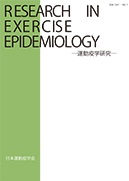Objective: Recent studies suggested the importance of neighborhood environment as physical activity determinants. However, most of these studies were conducted using young or middle-aged adult population. In addition, few studies have been investigated in Japan. The aim of this study was to examine the association of walking for transportation/recreation and perceived neighborhood environment among adults aged 60-69 years in Fujisawa city.
Methods: The study included 1,917 adults aged 60-69 years in Fujisawa city National Health Insurance beneficiaries, who had taken the Specific Health Checkups focused on metabolic syndrome (Tokutei Kenshin) in 2009 and responded to a mailed cross-sectional survey in 2010. The health checkup data (body mass index; BMI), sociodemographic attributes (age, education, employment status, household economy, self-rated health), the long version of International Physical Activity Questionnaire and its Environment Module were obtained. The odds ratio (OR) of walking for active transportation and walking for active recreation was calculated in relation to environmental characteristics and adjusted for sociodemographic attributes and BMI.
Results: Several perceived neighborhood environmental factors were associated with walking for transportation and recreation in both men and women. Good access to shops (male: OR=1.64, female: OR=1.43), presence of sidewalks (OR=1.35, OR=1.77) and no household motor vehicles (OR=2.56, OR=1.81) were associated with longer walking time for transportation. Social environment (OR=1.67, OR=1.57) and aesthetics (OR=1.32, OR=1.40) were associated with longer walking time for recreation. Good access to public transport (OR=2.31) for men and traffic safety (OR=0.73) for women were associated with longer walking time for transportation. And good access to recreational facilities (OR=1.34) for women was associated with longer walking time for transportation. Similar tendency was shown in men. Not owing household motor vehicles (OR=1.74) for men was associated with longer walking time for recreation.
Conclusions: The association between walking and neighborhood environment were differed by purpose of walking (transportation and recreation) among aged 60-69 years. The difference between men and women, which had been repeatedly reported in previous studies among adults, seemed small in the present study targeting the elderly. These findings include implications for environmental interventions to promote physical activity among elderly.
View full abstract
